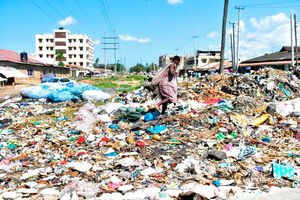
A truck collects garbage in Nairobi City.
A clash over mega-buck tenders and a deathly drive to control the thriving Nairobi garbage industry are pushing the Kenyan capital into deeper rot as the envisaged plan to construct a 45-megawatt electricity generation plant to power manufacturing and homes is hijacked by power brokers.
The controversy in the Nairobi City County over the right to construct a 45-megawatt power generation plant at the Dandora Dumpsite now threatens to further slide Nairobi into an environmental disaster since its transformation into a regional government 15 years ago.
As the tussle over the lucrative Sh48 billion Dandora Waste to Power Plant project tender builds, the United Nations Environment Programme (UNEP) warns the sprawling Dandora Dumpsite constitutes a dangerous ecological and health threat to the city population of more than five million people, which the electricity generation project was intended to ameliorate.
The dispute over the lucrative Waste to Energy Plant Project that has evolved into a bitter business and tendering fight pits the Kenya Electricity Generating (KenGen) against a Chinese engineering firm.
KenGen, which had been given the green light to build the electricity generation plant by the Ministry of Environment and Natural Resources via a letter dated August 9, 2021.
Nairobi Metropolitan Services
“It has been confirmed to Nairobi Metropolitan Services (NMS) by Ministry of Energy that KenGen has completed the feasibility studies for waste to Energy Plant in Nairobi City County, and that all the necessary clearances obtained from stakeholders…This is to request you to issue the title deed as the Waste to Energy Power Plant will require it.
Nairobi Metropolitan Services has already given its concurrence to the Ministry of Energy to go ahead and implement this vital (presidential directive) project on the site,” says the letter signed by then-Deputy Director General Kang’ethe Thuo on behalf of former Director-General for the defunct Nairobi Metropolitan Services, Lt-Gen Mohammed Abdalla Badi. The project should have been in the latter stages of implementation or completed if the initial timeline of 12 months had been retained.
“The project will be in Dandora. The only thing the county government is doing is provision of land. The cost of construction and maintenance will be borne by the company that was given the tender. What they have proposed is still within the Sh48 billion budget. If there is any technology that comes up and is better than what we have agreed to work with, then we’ll consider it.
The cost doesn’t matter to us as long as we get the right technology,” says Nairobi City Country chief officer for environment, Ibrahim Auma Nyangoya. Nairobi generates more than 3,000 tonnes of solid garbage daily. Over the years, the city authorities have been unable to cope with the surge in garbage, necessitating the need for recycling.
The Dandora dumpsite has morphed into a perilous “recycling economy” where around 3,000 families scavenge for plastic, food, clothes, paper and bottles to re-sell for income. A recent Unep study found that manual scavenging exposes workers to pollution and serious health risks due to hazardous elements like lead, mercury, and cadmium present in the waste.
The study says the Dandora dumpsite is a glaring example of environmental injustice, affecting the poor settlements in Nairobi while being polluted by waste from the entire greater Nairobi region. Documents in our possession show that the plan to generate power from the Dandora dumpsite that covers more than three acres of land – and even sprawls into the adjoining slum of more than 3,000 households – was mooted during the reign of Governor Evans Kidero in 2012.
However, when Dr Kidero left office, it slipped into dormancy until 2021 when NMS revived it as part of the long-term solution to garbage management in Nairobi that would create 1,000 indirect and 250 direct jobs, correspondence between the office of the president, ministry of lands, ministry of environment, treasury and KenGen show. In a memo dated August 12, 2021, former head of civil service Joseph Kinyua gave the all-clear to NMS, Ministry of Energy and KenGen to commence the project and ensure it was completed in 12 months.
Against this backdrop, it is not clear at what stage Governor Johnson Sakaja dumped KenGen for the Chinese firm. No reason was also given regarding the need for another feasibility study that settled on Ruai Sewer Plant River Bank as most suitable location instead of the envisaged Dandora dumpsite. The variation of the site of the plants was the subject of a legal tussle that the Environmental Court resolved in favour of Ruai Sewer Plant River Bank.
Reads: Secrets of State cartels
Nyangoya explains that the KenGen contract was shelved because it was signed with NMS. When the Sakaja government took the reins of power, the agreement became moot. In the August 12, 2021, letter Kinyua directed the Ministry of Energy to immediately take “necessary steps towards the development of Waste to Energy Power Plant at Dandora.
Among other things, the ministry was to get the requisite approvals and liaise with the National Treasury to raise financing for the engineering, construction and commissioning of the Waste to Energy Power Plant project. The other was to support infrastructure development – access roads, electricity, water, sewerage system and any other necessary utilities – to ensure the project was done within deadlines.
The letter also required that NMS provide “land within or around the Dandora Dumpsite land, and the solid waste at such terms and conditions as may be agreed.”
“It is the wish of the government to have this plant ready and operational within the shortest possible time period. In this regard, your ministry should establish a working framework with NMS, with specific time-bound deliverables so as to ensure the plant is installed and commissioned within a period of 12 months,” the memo says.







